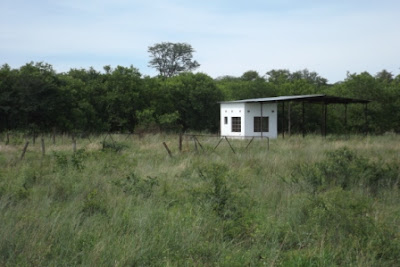These are worrying
times for Zimbabwe. Last week, Bulawayo, Harare and elsewhere were in turmoil with
protests over the economic situation in the Country, but at Sinamatella we were
cut off from the rest of the world by the government's shutdown of the internet
combined with a two-day power failure. This is not meant to be a political or
current affairs blog so I won't comment further on the events of the week away
from Sinamatella except to hope that there will be a happy ending to this very
long-running story. What that happy ending might be is anybody's guess but
let's hope that it is better than the one we thought we had reached in November
2017 - which turns out to have been neither happy, nor the end.
So, the week at
Sinamatella. Over the years that we have lived here we have noticed (we think)
a steady increase in the amount of bare, eroded ground we can see as we look
out over the park from the top of the hill. Rainwater rushing over the surface has caused
sheet erosion which continues every rainy season........
And the depth of the soil loss is shown by the exposed roots
on this old Mopane stump.....
We have no measurements to show that the bare areas are
increasing but even if they are not, they are still a worry. We put a lot of
effort into providing water for the animals but that is of no value if they
don't also have food. This isn't a new idea - the Parks Authority staff worked
on veld reclamation right into the 90's but nothing has been done since then so
we decided that this should be the year that we start again, trying to do
something about the situation.
Towards the end of
last year, the Hwange Conservation Society (UK) very kindly agreed to fund an
experimental piece of veld reclamation that we can replicate on a larger scale
if it is a success. We chose a piece of land close to Sinamatella that has been
heavily affected by sheet erosion but is easily accessible for the necessary
work and for monitoring afterwards. Most of it looks like this.....
But our aim is to get it looking like this piece of land,
only a couple of hundred meters away.........
I know, from
speaking to some of the people involved in reclamation in the past, that they relied
mainly on laying down brush lines (that's lines of cut bush that provide shade
and protection from grazers for delicate grass seedlings). Professor Google and
good old-fashioned books I've looked at suggest that breaking up the soil crust
is also important and we know that works from having seen the effect of laying
pipelines under bare ground for game water - the disturbed soil quickly becomes
well covered with vegetation. So, we decided to try out a variety of
methods....1. brush lines alone, 2. breaking up the soil in lines with a ripper
then covering with brush and 3. breaking the soil but not laying brush lines.
And so, to work.
First, cutting
brush. It would be a bit counter-productive to destroy useful vegetation in an
experiment on encouraging vegetation so we cut the brush where it isn't wanted
- along the edges of the Sinamatella airstrip. The airstrip isn't much used.
The last time a plane landed was in September 2017 so the strip......
And the airport buildings (departure lounge, customs and
immigration, duty-free shop - that sort of thing )........
....... are a bit neglected.
We loaded the cut brush into our old Land Cruiser
(affectionately known as 'Granny')........
While the tractor was doing the heavy work, ripping the soil
at the experimental plot......
Then we laid out the brush lines....
.....and thought we had finished.
It all looked very
neat and we were rather proud of it. I suppose that was the mistake because a
couple of hours later a heavy storm with very strong winds swept across the
whole thing and scattered our neat brush lines as if they were made of paper.
That's what experimenting is about of course - you learn by testing out ideas
and clearly, unsupported brush lines are an idea that doesn't work. Faced with
either having to add a lot more brush to make it all much heavier or pegging
the lines down with rough stakes, we decided on the stakes and that has now
been done. From here we have to monitor
the success or otherwise of the various plans and then decide if we want to
scale the programme up before next rainy season. No doubt I'll have more to say
on this in the next few months.














